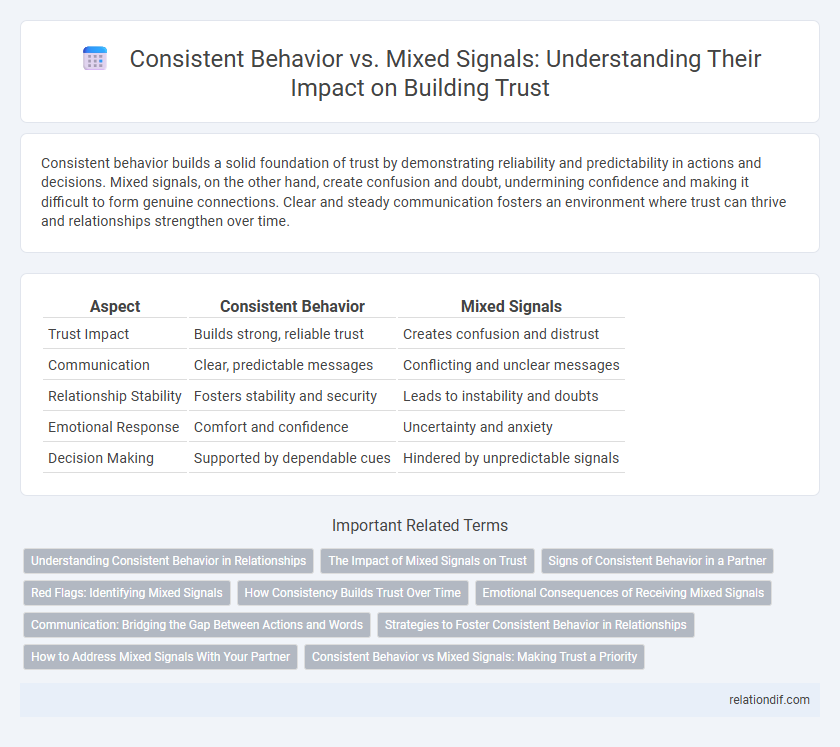Consistent behavior builds a solid foundation of trust by demonstrating reliability and predictability in actions and decisions. Mixed signals, on the other hand, create confusion and doubt, undermining confidence and making it difficult to form genuine connections. Clear and steady communication fosters an environment where trust can thrive and relationships strengthen over time.
Table of Comparison
| Aspect | Consistent Behavior | Mixed Signals |
|---|---|---|
| Trust Impact | Builds strong, reliable trust | Creates confusion and distrust |
| Communication | Clear, predictable messages | Conflicting and unclear messages |
| Relationship Stability | Fosters stability and security | Leads to instability and doubts |
| Emotional Response | Comfort and confidence | Uncertainty and anxiety |
| Decision Making | Supported by dependable cues | Hindered by unpredictable signals |
Understanding Consistent Behavior in Relationships
Consistent behavior in relationships builds trust by establishing predictability and reliability, allowing partners to feel secure and valued. Mixed signals create confusion and erode confidence, leading to misunderstandings and emotional distance. Prioritizing transparent communication and steady actions strengthens the foundation of mutual respect and deepens relational bonds.
The Impact of Mixed Signals on Trust
Mixed signals undermine trust by creating confusion and uncertainty in interpersonal relationships or organizational settings. When actions contradict words or previous behaviors, individuals struggle to predict responses, leading to decreased reliability and increased skepticism. Consistent behavior reinforces trust by establishing clear expectations and demonstrating integrity over time.
Signs of Consistent Behavior in a Partner
Consistent behavior in a partner is evident through reliable actions that align with their words, demonstrating integrity and dependability over time. Clear communication and predictable emotional responses reinforce trust, minimizing confusion and doubt in the relationship. Observable patterns such as keeping promises, showing genuine care, and maintaining transparency serve as strong indicators of a trustworthy and committed partner.
Red Flags: Identifying Mixed Signals
Mixed signals often manifest as inconsistent actions that contradict previous promises or statements, raising red flags in trust-building. Identifying these behaviors--such as fluctuating communication frequency, unexplained secrecy, or sudden changes in tone--helps detect potential deception or unreliability. Recognizing mixed signals early prevents emotional harm and supports healthier, transparent relationships founded on consistent behavior.
How Consistency Builds Trust Over Time
Consistent behavior reinforces reliability by creating predictable interactions that strengthen trust between individuals or organizations. Repeatedly aligning actions with words eliminates confusion and uncertainty, fostering a sense of security and confidence. Over time, this unwavering consistency forms a solid foundation for lasting relationships built on trustworthiness and integrity.
Emotional Consequences of Receiving Mixed Signals
Receiving mixed signals disrupts emotional stability, leading to confusion and increased anxiety. This inconsistency undermines trust by fostering doubt and insecurity in personal relationships. Prolonged exposure to mixed messages can result in emotional exhaustion and diminished self-esteem.
Communication: Bridging the Gap Between Actions and Words
Consistent behavior strengthens trust by aligning actions with clear, reliable communication, reducing confusion and fostering transparency. Mixed signals disrupt this alignment, causing doubt and misinterpretation in relationships where clarity is essential. Effective communication bridges the gap by ensuring that intentions are conveyed accurately and behaviors consistently reinforce verbal messages.
Strategies to Foster Consistent Behavior in Relationships
Consistent behavior in relationships builds trust by creating predictability and reliability in interactions, reducing misunderstandings and emotional uncertainty. Strategies to foster this consistency include clear communication of expectations, active listening to understand partners' needs, and regularly affirming commitments through actions rather than words alone. Establishing routine check-ins and practicing transparency can further reinforce trust, minimizing the impact of mixed signals that often lead to confusion and weakened bonds.
How to Address Mixed Signals With Your Partner
Addressing mixed signals with your partner requires open communication to clarify intentions and feelings, fostering trust and emotional safety. Establishing clear boundaries and expectations minimizes misunderstandings and reinforces consistent behavior, which strengthens relationship stability. Regular check-ins promote mutual understanding, helping to align actions with words and build deeper trust.
Consistent Behavior vs Mixed Signals: Making Trust a Priority
Consistent behavior establishes clear expectations and reinforces reliability, which strengthens trust in relationships. Mixed signals create confusion and doubt, undermining confidence and making it difficult to build a secure foundation. Prioritizing consistent actions ensures transparency, fosters mutual respect, and cultivates long-term trust.
Consistent behavior vs mixed signals Infographic

 relationdif.com
relationdif.com